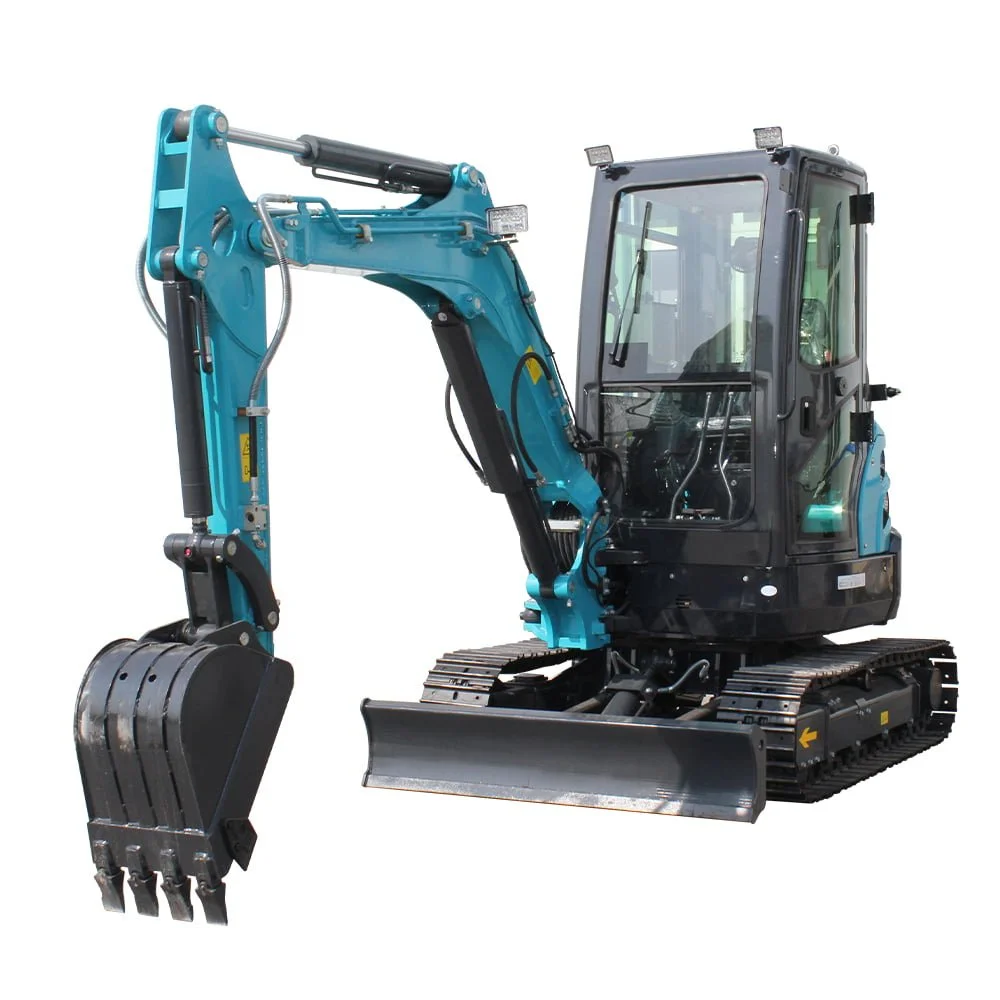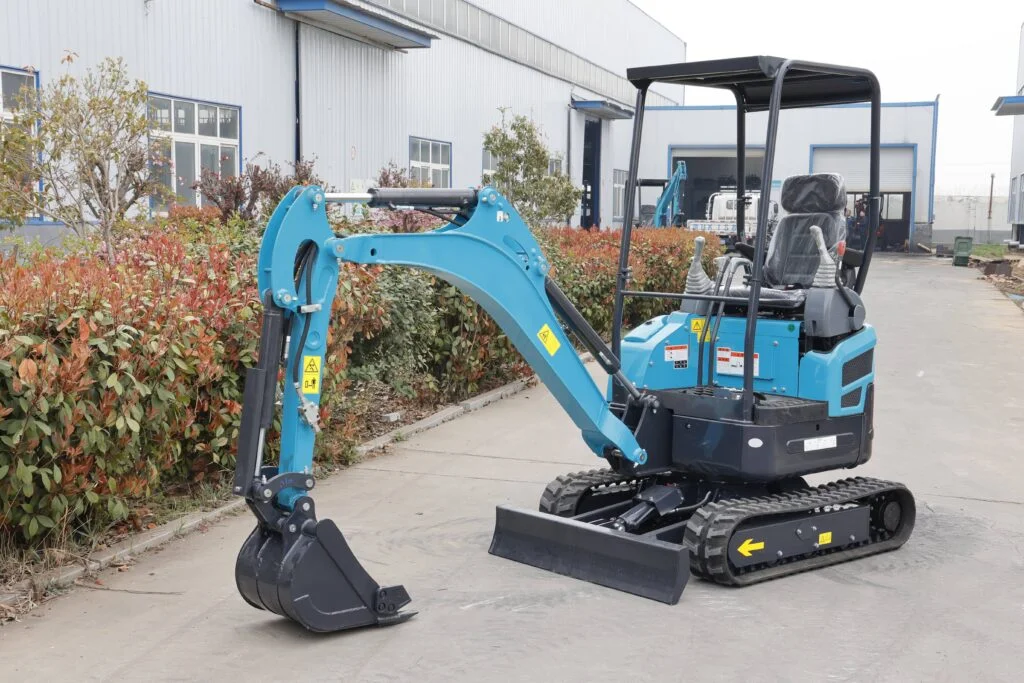E-mail: [email protected] WhatsApp: 8618266768780
Comment choisir la petite excavatrice adaptée à vos besoins
Bienvenue sur mon blog !
Avant de plonger dans le contenu, j'aimerais que vous me rejoigniez sur mes plateformes de médias sociaux où je partage plus d'informations, interagis avec la communauté et publie des mises à jour. Voici comment vous pouvez me contacter :
Facebook : https://www.facebook.com/profile.php?id=100072217509763
LinkedIn : https://www.linkedin.com/company/74949059/admin/dashboard/
YouTube :https://www.youtube.com/@tractormanufacturer-lc5qz
TikTok : https://www.tiktok.com/@tractormanufacturer
Commençons maintenant notre voyage ensemble. J'espère que vous trouverez le contenu ici instructif, engageant et utile.
Introduction
Pour les travaux de construction, d'aménagement paysager et de terrassement, il est essentiel de disposer du bon équipement. L'une des machines les plus polyvalentes dans ce domaine est la petite excavatrice. Ces machines compactes sont parfaites pour les espaces restreints et les petits projets, ce qui en fait un choix populaire pour les entrepreneurs et les bricoleurs. Dans ce guide, nous explorerons les facteurs à prendre en compte lors du choix d'une petite excavatrice, les avantages de son utilisation et comment s'assurer qu'elle répond à vos besoins spécifiques.
À la fin de cet article, vous aurez une compréhension complète des petites excavatrices, de leurs caractéristiques et de la manière de sélectionner celle qui convient le mieux à vos besoins.
Qu'est-ce qu'une petite excavatrice ?

Définition de la petite excavatrice
Une petite excavatrice, également connue sous le nom de mini-excavatrice ou excavatrice compacte, est une machine de petite taille utilisée pour creuser, soulever et déplacer des matériaux. Ces machines sont généralement conçues pour être légères, ce qui les rend idéales pour les petits travaux et les projets qui nécessitent de la précision. Leur taille compacte leur permet de manœuvrer dans des espaces confinés où les excavatrices plus grandes ne peuvent pas fonctionner efficacement.
Caractéristiques des petites excavatrices
Les petites excavatrices sont dotées de diverses fonctionnalités qui les rendent efficaces et faciles à utiliser. Certaines caractéristiques communes incluent :
- Débattement de flèche variable:Cela permet à l'excavatrice de creuser dans des endroits restreints sans avoir à repositionner l'ensemble de la machine.
- Rails réglables:De nombreuses petites excavatrices sont équipées de chenilles réglables, qui peuvent être élargies ou rétrécies en fonction des exigences du travail.
- Accessoires hydrauliques:Les petites excavatrices peuvent être équipées de divers accessoires, tels que des godets, des tarières et des grappins, pour améliorer leur fonctionnalité.
- Commandes conviviales:Ces machines disposent souvent de commandes intuitives, ce qui les rend faciles à utiliser même pour les débutants.
Avantages de l'utilisation d'une petite excavatrice
Maniabilité
L'un des principaux avantages des petites excavatrices est leur maniabilité. Leur taille compacte leur permet de travailler dans des espaces confinés, tels que les arrière-cours résidentielles ou les chantiers de construction étroits. Cela les rend idéales pour l'aménagement paysager, le creusement de tranchées et d'autres projets où l'espace est limité.
Rentabilité
Les petites excavatrices sont généralement plus abordables que leurs homologues de plus grande taille, ce qui en fait une solution rentable pour les petits projets. De plus, leur efficacité énergétique contribue à réduire les coûts d'exploitation au fil du temps, ce qui vous permet de maximiser votre budget.
Polyvalence
Ces machines sont incroyablement polyvalentes et peuvent effectuer une grande variété de tâches. Que vous ayez besoin de creuser, de soulever ou de transporter des matériaux, une petite excavatrice peut s'adapter à diverses applications, de l'aménagement paysager aux travaux de plomberie et d'électricité.
Facilité de transport
Les petites excavatrices sont légères et s'adaptent souvent à des remorques standard, ce qui les rend faciles à transporter d'un chantier à un autre. Cette mobilité permet aux entrepreneurs de passer rapidement d'un projet à l'autre sans avoir à transporter de gros équipements.
Sécurité renforcée
La conception des petites excavatrices accorde souvent la priorité aux dispositifs de sécurité, tels que les systèmes de protection contre le retournement (ROPS) et les ceintures de sécurité. Ces caractéristiques contribuent à garantir la sécurité de l'opérateur lorsqu'il travaille dans des conditions difficiles.
Facteurs à prendre en compte lors du choix d'une petite excavatrice
Exigences du projet
La première étape pour choisir la petite excavatrice adaptée consiste à évaluer les exigences de votre projet. Tenez compte des facteurs suivants :
- Type de travail:Quel type de tâches effectuerez-vous ? Creuserez-vous, soulèverez-vous ou déplacerez-vous des matériaux ?
- Capacité de poids: Déterminez le poids des matériaux que vous allez manipuler. Assurez-vous que l'excavatrice peut soulever et transporter ces matériaux en toute sécurité.
- Profondeur de l'excavation:À quelle profondeur devez-vous creuser ? Assurez-vous que l'excavatrice possède la profondeur de creusement requise pour votre projet.
Taille et poids
Les petites excavatrices sont disponibles en différentes tailles et poids. Lors du choix d'une machine, tenez compte des éléments suivants :
- Poids opérationnel: Choisissez un poids adapté au terrain de votre projet. Les machines plus lourdes risquent de ne pas être efficaces sur un sol meuble.
- Dimensions:Tenez compte de la taille globale de l’excavatrice, y compris la largeur et la hauteur, pour vous assurer qu’elle peut s’adapter à votre zone de travail.
Force hydraulique
La puissance hydraulique est essentielle pour les performances d'une petite excavatrice. Recherchez des machines dotées de :
- Débits hydrauliques élevés:Un débit plus élevé permet un fonctionnement plus rapide et la possibilité d'utiliser des accessoires plus puissants.
- Conception du système hydraulique:Vérifiez si le système hydraulique est conçu pour être durable et facile à entretenir.
Options de fixation
Lorsque vous choisissez une petite excavatrice, tenez compte des types d'accessoires dont vous pourriez avoir besoin. Les accessoires les plus courants sont les suivants :
- Seaux:Pour creuser et déplacer des matériaux.
- Tarières:Pour percer des trous.
- Grappins:Pour le levage et la manutention de matériaux volumineux.
- Disjoncteurs:Pour briser le béton ou l'asphalte.
Assurez-vous que l’excavatrice que vous choisissez peut accueillir les accessoires dont vous avez besoin.
Réputation de la marque
Renseignez-vous sur la réputation des marques que vous envisagez de choisir. Recherchez des fabricants connus pour produire des machines fiables et de haute qualité. Pensez à lire les avis des clients et à demander des recommandations à d'autres entrepreneurs.
Tableau : Comparaison des modèles populaires de petites excavatrices
| Marque et modèle | Poids opérationnel | Profondeur de creusement | Puissance |
|---|---|---|---|
| Qilu QLN20 pro | 2 000 livres | 7,8 pieds | 20 cv |
| Bobcat E35 | 3 000 livres | 11,5 pieds | 25 cv |
| Caterpillar 302.7 CR | 3 500 livres | 12,5 pieds | 30 cv |
| Komatsu PC30MR-5 | 4 200 livres | 13,1 pieds | 27 ch |
| Kubota KX040-4 | 4 800 livres | 12,8 pieds | 40 cv |
Utilisations courantes des petites excavatrices
Aménagement paysager
Les petites excavatrices sont fréquemment utilisées dans les projets d'aménagement paysager pour creuser des trous pour planter des arbres, des arbustes et des parterres de fleurs. Leur capacité à manœuvrer dans des espaces restreints les rend parfaites pour l'aménagement paysager résidentiel.
Creusement de tranchées
Pour les travaux de plomberie et d'électricité, les petites excavatrices sont idéales pour creuser des tranchées. Leurs capacités de creusement permettent de creuser des tranchées avec précision sans endommager les zones environnantes.
Nivellement et mise à niveau
Les petites excavatrices peuvent être équipées d'accessoires de nivellement pour niveler le sol, le gravier ou d'autres matériaux. Cela est particulièrement utile pour préparer les sites de construction ou d'aménagement paysager.
Préparation du site
Avant de commencer tout projet de construction, les petites excavatrices peuvent préparer le site en dégageant les débris, en retirant la terre végétale et en creusant des zones pour les fondations ou les semelles.
Travaux d'utilité publique
Les entreprises de services publics utilisent souvent de petites excavatrices pour installer et réparer des lignes souterraines, telles que l'eau, le gaz et l'électricité. Leur taille compacte leur permet de travailler dans des environnements urbains avec un accès limité.
Conseils d'entretien pour les petites excavatrices

Inspections régulières
Inspectez régulièrement votre petite excavatrice pour vous assurer qu'elle est en bon état de fonctionnement. Vérifiez qu'elle ne présente aucun signe d'usure, notamment des fuites hydrauliques, des chenilles endommagées et des accessoires usés.
Gardez-le propre
Nettoyer votre petite excavatrice après utilisation permet d'éviter l'accumulation de saletés et de débris, qui peuvent entraîner de la corrosion et des problèmes mécaniques. Portez une attention particulière aux composants hydrauliques et au train de roulement.
Changer les liquides régulièrement
Changez régulièrement l'huile et les liquides hydrauliques selon les recommandations du fabricant. Cela permet de maintenir des performances optimales et de prolonger la durée de vie de votre petite excavatrice.
Entreposer correctement
Lorsque vous ne l'utilisez pas, rangez votre petite excavatrice dans un endroit sec et abrité pour la protéger des intempéries. Cela peut empêcher la rouille et les dommages à la machine.
Suivez les directives du fabricant
Suivez toujours les consignes et recommandations d'entretien du fabricant. Un entretien adéquat est essentiel pour assurer la longévité et l'efficacité de votre petite excavatrice.
Conclusion
Pour choisir la petite excavatrice adaptée à vos besoins, vous devez prendre en compte divers facteurs, notamment les exigences du projet, la taille et la réputation de la marque. Ces machines compactes offrent de nombreux avantages, notamment la maniabilité, la rentabilité et la polyvalence, ce qui en fait un excellent choix pour une large gamme d'applications.
En comprenant les caractéristiques et les options disponibles sur les petites excavatrices, vous pouvez prendre des décisions éclairées qui amélioreront votre productivité et votre efficacité sur le chantier. Que vous soyez un entrepreneur ou un bricoleur, investir dans la bonne petite excavatrice vous aidera à réaliser vos projets en toute simplicité.
FAQ
Quel est le principal avantage d’utiliser une petite excavatrice ?
Le principal avantage de l’utilisation d’une petite excavatrice est sa maniabilité, la rendant idéale pour travailler dans des espaces restreints où les machines plus grandes ne peuvent pas fonctionner.
À quelle profondeur une petite excavatrice peut-elle creuser ?
La profondeur de creusement d'une petite excavatrice peut varier selon le modèle, mais beaucoup peuvent creuser entre 10 et 18 pieds, selon la machine spécifique et sa configuration.
Puis-je utiliser une petite excavatrice pour l’aménagement paysager résidentiel ?
Oui, les petites excavatrices sont fréquemment utilisées pour les tâches d’aménagement paysager résidentiel, comme creuser des trous pour les plantes et niveler le sol.
Combien pèse généralement une petite excavatrice ?
Les petites excavatrices pèsent généralement entre 2 000 et 6 000 livres, selon le modèle et la configuration.
Quels types d’accessoires peuvent être utilisés avec les petites excavatrices ?
Les accessoires courants pour les petites excavatrices comprennent des godets, des tarières, des grappins et des concasseurs, qui améliorent leur polyvalence pour diverses tâches.
À propos de nous
Shandong Qilu Industrial Co., Ltd. est un fabricant et exportateur professionnel intégrant le développement et la production d'excavatrices, de chargeurs et de tracteurs. Nous fournissons le meilleur service, absolument.
Messages récents
Démo vidéo
-1.png)
Contactez-nous aujourd'hui !
Une question, un devis ou une demande ? Cliquez sur le bouton pour envoyer le message.
Qilu Industrial sera toujours là pour vous aider.
